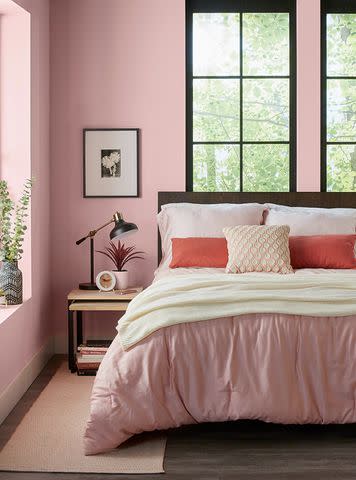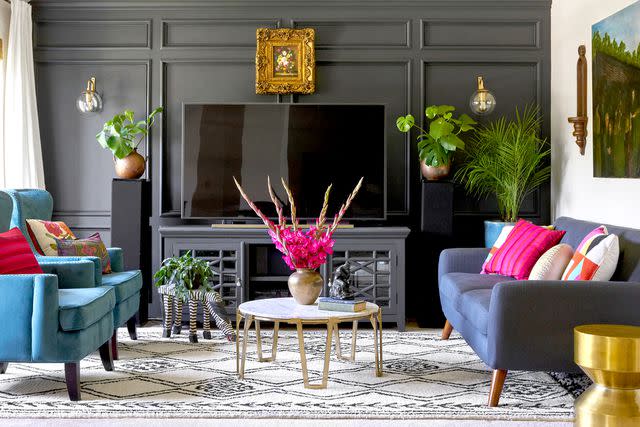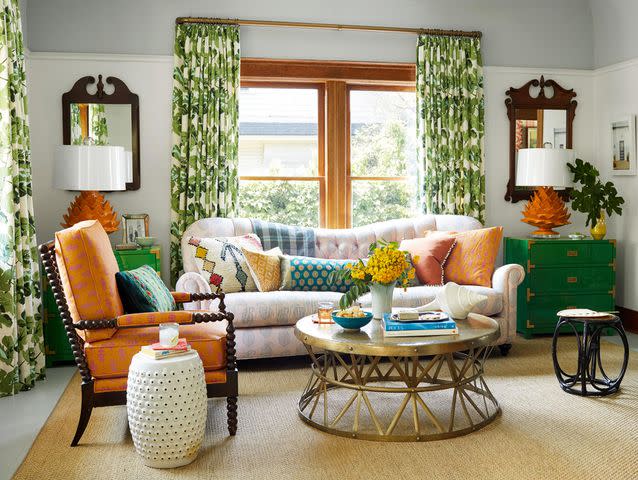How to Use the Color Wheel to Pick the Right Palette for Any Room

This simple tool can help you choose color combinations that work well together.
The color wheel is a simple tool for picking paint colors and deciding which hues go together. Every decorative color combination can be defined by where it resides on the wheel, a diagram that maps the colors of the rainbow. The wheel makes color relationships easy to see by dividing the spectrum into 12 basic hues: three primary colors, three secondary colors, and six tertiary colors. When you learn how to use color wheel theory—and its hundreds of combinations—it is a helpful reference for deciding which colors to try in your home.
The Color Wheel and How It Works
A color wheel has 12 sections, each one representing a color. There are three primary colors, three secondary colors, and six tertiary colors.
Primary colors are red, blue, and yellow. These colors are pure, which means you can't create them from other colors, and all other colors are created from them.
Secondary colors are orange, green, and purple. These hues line up between the primaries on the color wheel because they are formed when equal parts of two primary colors are combined.
Tertiary colors are formed by mixing a primary color with a secondary color next to it on the color wheel. With each blending (primary with primary, then primary with secondary), the resulting hues become less vivid. Tertiary colors include:
Red-orange
Yellow-orange
Yellow-green
Blue-green
Blue-violet
Red-violet
Refer to the color wheel chart to distinguish primary, secondary, and tertiary colors.

BHG /Zoe Hansen
Related: How to Decorate with Primary Colors for a Bold, Retro-Inspired Look
How to Use the Color Wheel to Build Color Schemes
You can rely on the color wheel's segmentation to help you mix colors and create palettes with varying degrees of contrast. There are four common types of color schemes derived from the color wheel.
Monochromatic Color Scheme

A tone-on-tone monochromatic color scheme uses several shades (adding black) and tints (adding white) of a single hue for a subtle palette. Think pale blue, sky blue, and navy. Make a monochromatic palette work by including a variety of shades and textures to make the room stand out. A bedroom color scheme in pink sticks to the pink wedge in the color wheel but includes various tints that range from blush to rosy.
You could also use small accessories for a pop of a brighter tone. Finally, a knit throw and woven rug add textural variety to the narrow color scheme.
Analogous Color Scheme

An analogous palette offers contrast and includes colors found side by side on the wheel—such as orange, yellow, and green—for a colorful but relaxing feel. Neighboring hues work well because they share the same base colors.
Pick one shade as the main color in a room. Then, choose one, two, or three shades to be accent hues. An analogous scheme of blue, purple, and fuchsia could include a dusty purple sofa providing the dominant shade, while vibrant fuchsia appears on throw pillows and in the flower arrangement. The pink and blue accents share the same purple undertones, so they suit the color wheel design. A warm gray wall color rounds out the room.
Complementary Color Scheme

Using two hues directly opposite each other on the color wheel, such as blue and orange, is guaranteed to add energy to any room. These complementary colors work well together because they balance each other visually. A bright shade of orange offers warmth and brightness that balances a deep cobalt blue (like you see in this Better Homes & Gardens 16oz Blue Fern & Citrus Scented Stoneware Candle, $12, Walmart). The key is not letting one color overtake the other. As the wall color, blue appears more prominently, while orange serves as an accent. The two colors appear on other elements throughout the space for a cohesive look.
Triadic Color Scheme

A triad creates an adventurous palette by using three hues evenly spaced on the wheel, such as turquoise, fuchsia, and yellow-orange. This combination forms a color palette with vivid contrasts and balanced colors (like you see in this Better Homes & Gardens Medallion Square Throw Pillow, $16, Walmart). These vibrant schemes work well because they offer a happy, energizing atmosphere. Use the three colors in varying shades and tints to create contrast or to soften the brightness. For instance, a living room can have saturated shades of orange and green and have a hint of a third color, like a neutral pastel couch.
Warm and Cool Colors
Color affects emotional responses and creates a mood. Greens tend to soothe, while yellows are uplifting and energetic. Bold reds are passionate and daring, but soft pink (a tint of red) is considered sweet and delicate. Blues are perceived as calming and quiet; oranges are warm and cozy; and purple, a truly complex color, can be seen as sexy or spiritual.
Colors are considered warm or cool because of association. The warm colors are reds, oranges, and yellows, while the cool colors are blues, greens, and violets. We associate warm colors with the warmth of the sun and fire, and cool colors with water, sky, and foliage. For a balanced look, don't limit your palette to all warm colors or all cool colors. Let one dominate and set the overall tone of the room, but include elements that offer contrast.
Color Wheel Terminology
Use this glossary of color wheel terms to help inform color decisions throughout your home.
Analogous: neighbors on the color wheel such as yellow, yellow-orange, and orange.

Chroma: a color's brightness or dullness
Complementary: opposites on the color wheel, which appear brighter when they are used together (examples: yellow and purple, red and green, blue and orange)

Neutral: common neutral colors are black, white, brown, and gray. These colors do not have high intensity or saturation and create a relaxing space.
Secondary: a combination of equal parts of two primary colors (secondary colors are green, orange, and purple)

Shade: any color with black added; also refers to slight variations in a color
Primary: pure colors (red, yellow, and blue) that combine to create all the other colors on the wheel

Split complementary: the grouping of a color with the two hues analogous to its complementary color (yellow with red-violet and blue-violet, for example)

Triad: any three colors equally spaced on the color wheel, one of which usually takes precedence in a color scheme (yellow-orange, blue-green, and red-violet, for example)
Tertiary: a combination of equal parts of a primary and a secondary color (red-orange, yellow-orange, yellow-green, blue-green, blue-violet, and red-violet.)

Tint: any color with white added
Tone: a color's intensity or its degree of lightness or darkness
For more Better Homes & Gardens news, make sure to sign up for our newsletter!
Read the original article on Better Homes & Gardens.